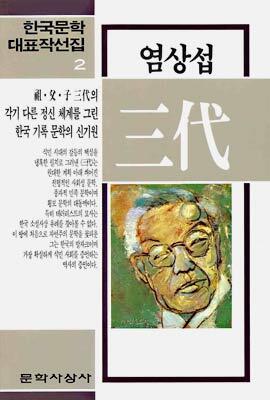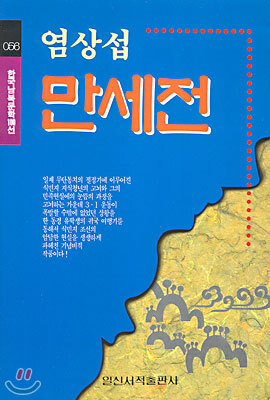Yom Sang-seop (1897–1963) was a South Korean novelist and freedom fighter.
Life
Yom was born in 1897 in Seoul and was educated in Japan. He graduated from Posung High School in 1915 and entered Keio University. After one semester, however, he dropped out and started a literary magazine with fellow writer Hwang Seok-u. Around this time, he became involved with the March 1st Movement and began to plan a rally in Osaka, Japan. For these efforts, he was arrested and put in prison but was subsequently acquitted on appeal.
In 1920, he returned to Korea and took a position as a reporter at the Dong-A Ilbo newspaper. He began writing fiction in earnest, associating the literary coterie Pyeheo. In 1921, Yom published his first story, "Pyobonsirui cheonggaeguri" (표본실의 청개구리 A Frog in the Specimen Room) in Kaebyok magazine.
During the 1920s, he became a proponent of a national literature for Korea and was one of the few writers who did not write in Japanese or publish fawning articles at the height of Japan's colonization. In 1928 he joined the Chosun Ilbo as main editor of the Arts and Science section. During the 1930s, he also served in editorial positions at the Maeil Shinbo and the Mansun Ilbo.
In 1946, following World War II, he became editor-in-chief of the Kyunghyang Shinmun. At the outbreak of the Korean War in 1950, he was appointed an officer in the Navy and served in a journalistic capacity at naval headquarters. He was appointed President of Seorabal College of Art in 1954 and, three years later, received an honorary degree in Public Administration from the Korea National Defense University.
Yom died of cancer on March 14, 1963, at the age of sixty-seven.
Writing
Yom Sang-seop was a pioneer of modern narrative in Korea and a "writer of the period of dissatisfaction". In this role, he was one of the first naturalistic and realistic writers in Korean literature. Early in his career, his role in the resistance to Japanese colonialism resulted in his arrest.
Yom made his literary debut in 1921 with "Pyobonsirui cheonggaeguri." The following year, Yom published one of his most famous works, the novella Mansejeon (만세전 On the Eve of the Uprising). From 1926 to 1928 Yom returned to Japan, where he wrote the novels Isim (이심 Two Minds) and Saranggwa joe (사랑과 죄 Love and Crime). Upon his return to Korea, while working at the Chosun Ilbo, Yom wrote a third novel, Gwangbun (광분 Running Wild).
Perhaps his most famous work is Samdae (삼대Three Generations), which was published in 1931. As was common at the time, the novel was published in serial format, in the Chosun Ilbo. The novel was not initially recognized as important and was not published as a book until 1948. In Three Generations, Yom calmly depicts the Korean people living in the colonial era. The focus of his observations in Three Generations is, so to speak, the lives of intellectuals and urban middle class families living in the 1930s.
As time went by, Yom’s importance to Korean literature was recognized. In 1953 Yom was honored with the Seoul Culture Award, three years later receiving the Asia Freedom Literature Award, and a year after that, in 1957, the National Academy of Arts’ Contribution Award. One year before his death in 1963, he was also awarded the March 1st Culture Award and the Korean President’s Medal.
Publicó su primera obra de ficción en 1919. En 1921, su historia "La rana de la sala de especímenes" se publicó en la publicación Amanecer de la historia y en 1922 se publicó otra de sus obras más famosas, "En la víspera de la revolución". Regresó a Japón y escribió las novelas Dos corazones y Amor y crimen. Mientras trabajaba en el periódico Chosun Ilbo, escribió su tercera novela Desbocado. Quizá su obra más famosa es Tres generaciones, una novela de 472 páginas publicada en 1931. Como era común en esa época, fue publicada en fascículos en el diario Chosun Ilbo. Sin embargo, no se reconoció como importante y no se publicó en forma de libro hasta 1948. Con el paso del tiempo se reconoció su importancia en la literatura coreana. En 1953 fue reconocido con el premio cultural de Seúl, tres años más tarde recibió el premio literario Asia Freedom y un año después, en 1957, recibió el premio a la contribución de la Academia Nacional de Artes. Un año antes de morir, también fue premiado con el Premio Cultural del 1 de Marzo y la Medalla del Presidente de Corea.
Il a publié son premier ouvrage en 1919 dans des revues Hakjigwang et Seomgwang. En 1921, son récit La grenouille dans la chambre à spécimens (Pyobonsirui cheong-gaeguri) fut publié dans la revue L'aube d'une nouvelle époque (Gaebyeok), et en 1922 un de ses plus célèbres récits, A la veille de l'insurrection (Mansejeon) fut également publié (et même traduit en anglais). Il est retourné au Japon où il a écrit les romans : Deux esprits (Isim) et Crimes et amour (Sarang-gwa joe). Tout en travaillant au sein du journal Chosun Ilbo, il a écrit un troisième roman intitulé Remous (Nallyu). Son roman sans doute le plus célèbre est Trois générations (Samdae), un roman de 472 pages publié en 1931. Comme cela se faisait souvent à l'époque, le roman a été publié en feuilleton dans le journal Chosun Ilbo. ; à l'époque, c'était la seule façon de publier un roman en Corée, le roman en tant que tel n'étant pas reconnu comme un travail de valeur, si bien que la publication de romans en format livre n'a vu le jour qu'en 1948.
Au fil du temps, son importance dans le développement de la littérature coréenne a été reconnu par ses pairs. En 1953, il a reçu par le Prix culturel de Séoul, recevant trois ans plus tard le Prix de la littérature libre d'Asie puis, un an après, en 1957, il se voit décerner le prix de la contribution nationale pour le développement des arts. Un an avant sa mort, en 1963, il a également reçu la Médaille de la culture des mains du président coréen.
Dans l'histoire moderne de la Corée, la littérature a toujours eu un rôle important, notamment par rapport aux coups de projecteurs qu'elle délivre sur les conditions de vie sociale des différentes époques. Yeom Sang-seop, qui a dépeint la souffrance de ses contemporains durant la colonisation a montré à quel point la littérature pouvait amener les lecteurs à réfléchir sur l'histoire et sur les conditions de vies. À ce titre, ses récits apparaissent comme un formidable support pour la connaissance de la société coréenne durant cette période de l'histoire.
廉 想渉(れん そうしょう、ヨム・サンソプ、1897年8月30日 - 1963年3月14日)は、朝鮮の小説家、言論人である。本名は尚燮。号は横歩。8人兄弟の3番目に生まれた。朝鮮文学にはじめて自然主義という語を植え付け、朝鮮の自然主義文学の祖となった。
염상섭(1897~1963)은 대한민국의 소설가다.
생애
염상섭은 1897년 서울에서 태어났다. 본명은 상섭(尙燮), 호는 횡보(橫步). 할아버지로부터 한문을 배우다가 1907년 관립사범부속보통학교에 입학하였으나 반일 학생으로 지목되어 중퇴하였다. 1912년 보성소·중학교를 거쳐 일본에 건너가 우여곡절 끝에 교토 부립 제2중학을 졸업하고 1918년 게이오대학 예과에 입학하였다. 대학 재학 중 오사카에서 자신이 쓴 〈조선독립선언문〉을 살포하고 시위를 주동하다가 일본 경찰에게 체포된 후, 학교를 중퇴하고 1920년 귀국하여 《동아일보》 창간 정치부기자로 활동했다. 한때 오산학교 교사로 재직한 일도 있지만, 이후 줄곧 신문·잡지 편집인으로 생활하면서 소설·평론에 전념하였다.
문예전문지 《폐허(廢墟)》의 동인으로 참여했고, 1921년 작가의 출세작인 〈표본실의 청개구리〉를 발표하면서 문단의 주목을 받았는데, 이 작품은 현재까지 한국소설사의 중요한 작품으로 남아있다. 1924년 중편소설 《만세전》 발표를 통해 뛰어난 소설적 감각과 현실인식을 드러내었다. 주간종합지 《동명》의 기자를 거쳐 1929년 《조선일보》 학예부장으로 활동하면서 〈민족사회운동의 유심적 고찰〉, 〈소설과 민중〉 등의 평론을 발표하기도 하였으나 주로 소설 창작에 전념하였다.
한편 작가는 1936부터 1945까지 만주·신경에 살면서 《만선일보》 편집국장·회사 홍보담당관 노릇을 하면서 작품을 발표하지 않았다. 1945년 광복과 더불어 귀국하여 다시 《경향신문》 초대 편집국장을 지내기도 하였으나 한국전쟁 중에는 해군 소령으로 입대하여 1953년 휴전이 되는 해까지 정훈(政訓) 담당으로 일했다. 1954년에는 한국전쟁 중의 서울의 모습을 그려낸 장편 《취우(驟雨)》로 서울시문화상을 수상했으며, 예술원 창설과 함께 종신회원으로 추대되었다. 1953년 이후 한때 서라벌예술대학장으로 일하기도 하였지만, 창작에 집중하여 병중에도 많은 작품을 집필하였다.
작가의 대표작으로는 장편소설 《삼대(三代)》(1931), 《무화과(無花果)》(1932), 《사랑과 죄》(1928), 《이심(二心)》(1939), 《효풍》(1948), 《취우》(1953) 등이 있다. 1963년 3월 세상을 떠날 때까지 작가는 식민지사회를 투철히 인식하면서 당대 사회의 현실을 묘파하는 작품들을 다수 남겼다.
작품 세계
염상섭은 한국의 전통적인 사상과 서양에서 유입된 문명을 모두 자신의 문학의 토대로 삼았다. 염상섭은 전통과 근대, 모더니즘과 리얼리즘, 도덕과 윤리, 정치와 역사 등 현실 세계의 경계를 구성하는 중요한 요소들을 탐구의 대상으로 삼아 인간의 본질을 이해하려는 시도를 멈추지 않았다. 특히 민족과 개인, 세계와 사회의 윤리에도 관심을 두고 식민지 현실을 부정하면서 작품에 담아내었다.
염상섭은 초기에는 암울하고, 침통한 분위기가 작품을 지배했으나, 사회와 역사적 현실을 작품의 소재로 삼기 시작하면서 작품의 분위기가 달라졌다. 특히 치밀한 관찰과 객관적 기술을 바탕으로 현실의 모순과 인간의 이면을 핍진하게 그려내었다. 1920년대 염상섭은 당시 문단에서 양대 세력을 형성하고 있던 민족주의와 사회주의 사이에서 중립적인 노선을 견지하고자 노력하였는데, 단편 〈윤전기(輪轉機)〉가 대표적인 작품이다.
《만세전》(1924)은 동경에서 경성으로 이동하는 주인공의 상념을 통해서 근대적 가치들에 대한 과도한 기대 및 반성, 그리고 식민지 현실에 대한 날카로운 인식을 드러낸다. 《만세전》은 근대성에 대한 추상적인 동경이 풍자의 대상으로 변하는 1920년대 전반기의 현실을 압축적으로 보여주는 작품이다.
한편 1931년 1월 1일부터 9월 17일까지 《조선일보》에 연재한 《삼대(三代)》는 식민지 현실을 배경으로 가족 간에 벌어지는 세대갈등을 그려낸 그의 대표작이다. 작품은 1930년대 서울의 보수적인 중인계층이며 식민지 중산층 집안인 조씨 집안의 몰락 과정을 그리고 있다. 이 작품은 날카로운 현실 인식을 바탕으로 하여, 한말 세대의 보수성과 개화기 세대의 정신적 파탄, 식민지 세대의 진보성으로 대표되는 삼대를 작품의 전면에 내세웠다. 또한 이 작품은 가족사를 통한 시대사의 재구(再構)로 요약할 수 있다. 특히 안정된 소설 구조와 개성 있는 인물의 유형, 복잡하지만 치밀한 사건 전개, 역사적·사회적인 주제 등 여러 가지 측면에서 한국 문학사의 기념비적인 작품이다.
1952년 7월부터 1953년 2월까지 《조선일보》에 연재한 장편소설 《취우》에서 작가는 전쟁으로 하루아침에 세상이 혼돈에 빠지자, 저마다의 생명과 가족만 생각하는 사람들 그리고 전쟁이 파괴한 질서 속에서 살아남은 사람들을 재현하고 있다. 작가는 전쟁으로 파괴되어 혼란만이 남은 현실을 해결할 수 있는 어떠한 결론이나 방법도 제시하지 않지만, 모든 가능성을 포기하지는 않는다.
주요 작품
1) 전집
《염상섭전집》(전11권), 민음사, 1987.
《염상섭 문장 전집》(전3권), 소명, 2014.
《염상섭 문학》(전11권), 글누림, 2017.
2) 소설집
《견우화》, 박문서관, 1924.
3) 장편소설
《만세전》, 고려공사, 1924.
《사랑과 죄》, 박문서관, 1931.
《이심(二心)》, 박문서관, 1939.
《삼대(三代)》, 을유문화사, 1947.
수상 내역
1956년 제3회 아시아자유문학상
1957년 예술원공로상
1962년에는 삼일문화상 예술부문





